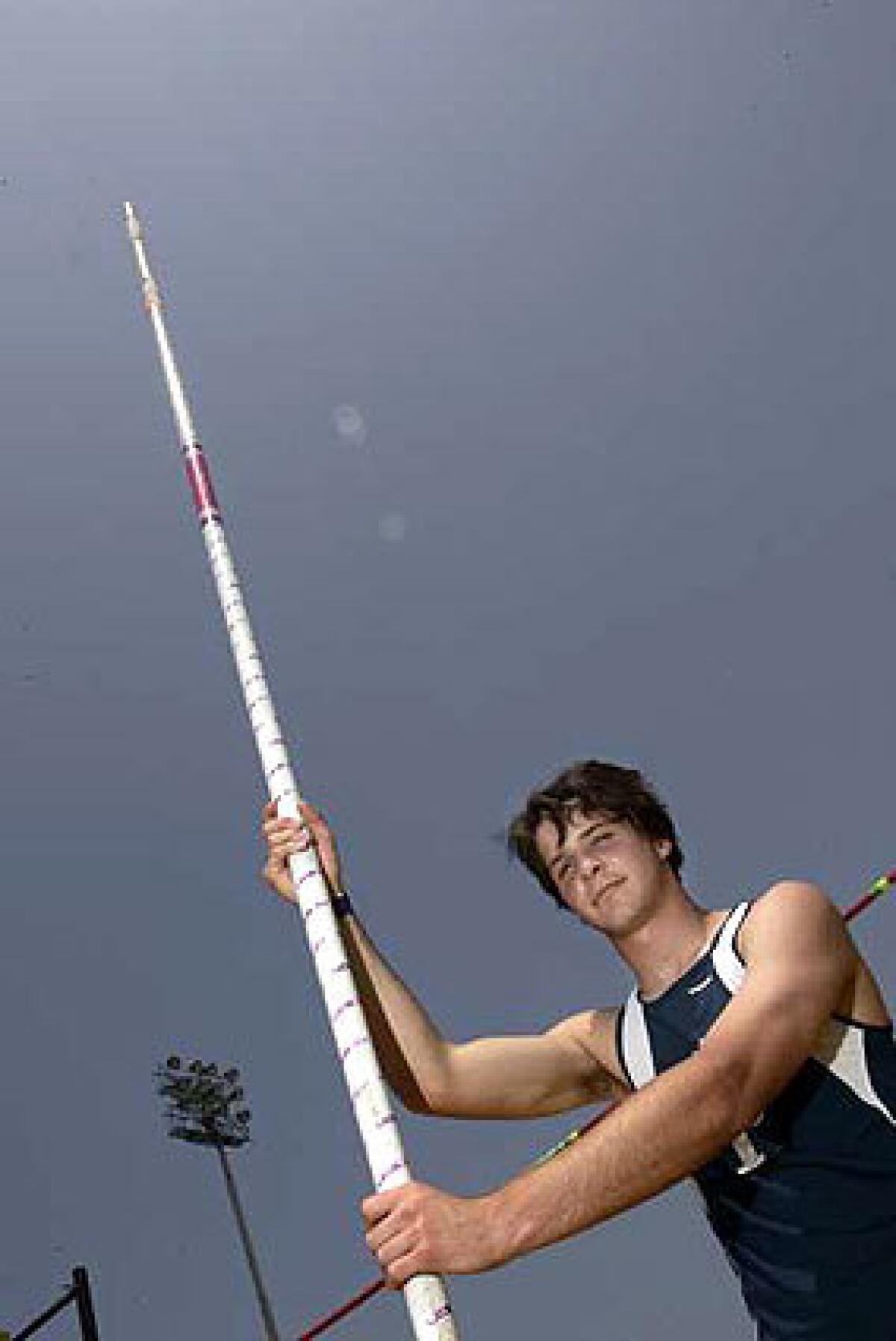Palisades’ Greenberg practices a lost art in high school track

- Share via
Motivated by watching the History Channel, Bryan Greenberg became a teenage anthropologist for a day, searching Palisades High for artifacts and evidence that it once had an ancient pole vault civilization.
“We dug through spider webs,” he said.
The moment of discovery came when Greenberg peered inside a deserted shed on campus and found a pole from the 1990s.
Welcome to the state of pole vaulting in the City Section, where it’s on the endangered list, bordering on extinction. Only 16 of the 55 comprehensive high schools held pole vault competitions during track and field meets this spring.
Greenberg, a 5-foot-11 senior, won the City title last season and figures to win it again Thursday afternoon at the City championships at Lake Balboa Birmingham primarily because he hired a private coach and trained on his own.
He’s a pole vault orphan, representing Palisades in name only because the school and the Western League don’t compete in the event. Neither did the schools from the Valley Mission and Coliseum leagues. Even Woodland Hills Taft, the defending City boys’ champion, has dropped the event.
A lack of certified pole vault coaches, liability concerns and costs of more than $10,000 for equipment have left one of the most exciting, exhilarating events in track and field in serious need of help.
“Pole vaulting was on the way out, then bringing girls in actually saved the sport,” Birmingham Coach Scott King said. “It had a revival for a while, then a number of rule changes for safety reasons meant bigger pits, different types of padding and requirements that cost money. Spending $7,000 to $10,000 to upgrade your pole vault pit can be used elsewhere, and that’s what has happened.”
Dean Balzarett, who is retiring after 41 years of coaching track at North Hills Monroe, used to coach the pole vault but dropped it from his program in 2003 out of a concern that if he wasn’t watching his vaulters every second and someone were injured, he’d be held responsible.
“You can’t live in fear,” he said.
Athletes whose schools don’t have a pole vault program must learn and train on their own. That’s what Greenberg did as a sophomore. A family friend told him about a pole vault clinic run by former state record-holder Anthony Curran on weeknights at Santa Monica High.
Greenberg, a free spirit who loved jumping on a trampoline, became immediately enthralled with the sport.
“I wouldn’t say I’m your run-of-the-mill kind of guy,” he said. “I’m a little kooky. I guess that’s what drove me to the sport — it’s dangerous. Every part of it is fun, from the takeoff to after making it, falling 15 feet, to being able to celebrate in midair. I like the collective gasp before you go over the bar and right before you make it.”
Pole vaulters are daredevils and entertainers. Like surfers and skateboarders, they fear nothing and thrive on conquering unconventional challenges.
Greenberg had to drop his drama class when it conflicted with his pole vault training, but he discovered he could still entertain “with victory dances.” He used to practice Brazilian jujitsu. He also likes karaoke, plays the guitar, is an expert at World of War Craft, an online computer game, and starred in “Midsummer Night’s Dream” at a Shakespeare festival.
Greenberg’s outgoing personality was on display during last week’s City preliminaries. He was lathering up with sun lotion and setting up his chair on the field when a couple of girl vaulters walked past. He said without hesitation, “Ladies, can I offer you some sunscreen?”
Saving the pole vault in the City Section is a must, if only to keep encouraging athletes like Greenberg to come out and provide entertainment.
Rule changes have made it a safer event. Long gone are the days of jumping into sawdust instead of foam rubber mats. In 2002, when three high school athletes died from pole vault injuries around the country, it was considered the most dangerous school-sanctioned athletic event, according to statistics compiled by the National Center for Catastrophic Sports Injury Research in Chapel Hill, N.C.
The next year, the size of the foam-rubber landing mat was increased.
Now cheerleading, with its emphasis on gymnastics, has probably replaced pole vaulting as the most dangerous sport, said Frederick Mueller, who directs the Chapel Hill-based research organization.
It should come as no surprise that the longest-surviving record in City Section track and field history is in the pole vault, where no one has been able to surpass the mark of 16 feet 7 inches established by Bob Pullard of Los Angeles High in 1969.
Greenberg cleared 15-0 during an invitational earlier this season.
“Let’s do it,” he said about trying to break Pullard’s record Thursday.
More important, though, is that Greenberg has offered to return to Palisades one day and serve as a pole vault coach. His sister, Jamie, a seventh-grader, has already cleared eight feet, and he wants to make sure she and others will have the chance to keep competing.
King proposes having the City Section hire a coach who specializes in skilled events, whether it be the pole vault, high jump or shotput, and hold clinics around the city to train the next generation.
“Any of the skilled events are endangered,” King said. “This isn’t something that somebody grows up with. The private route is really the future of track and field. There will be someone doing private coaching in the hurdles, in the high jump, in the pole vault at different places. That’s what we need.”
Greenberg is ready to sign up, as long as he gets to keep flying through the air on occasion.
--
Eric Sondheimer can be reached at eric.sondheimer@latimes.com.
More to Read
Go beyond the scoreboard
Get the latest on L.A.'s teams in the daily Sports Report newsletter.
You may occasionally receive promotional content from the Los Angeles Times.











